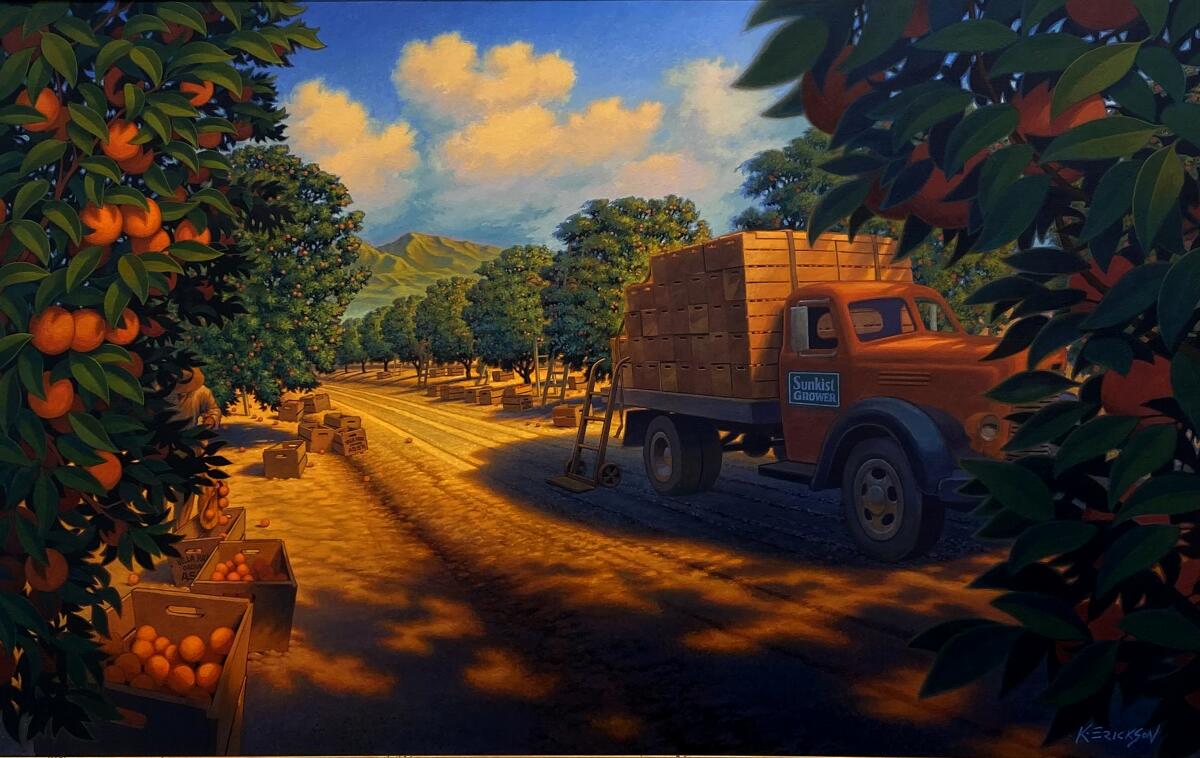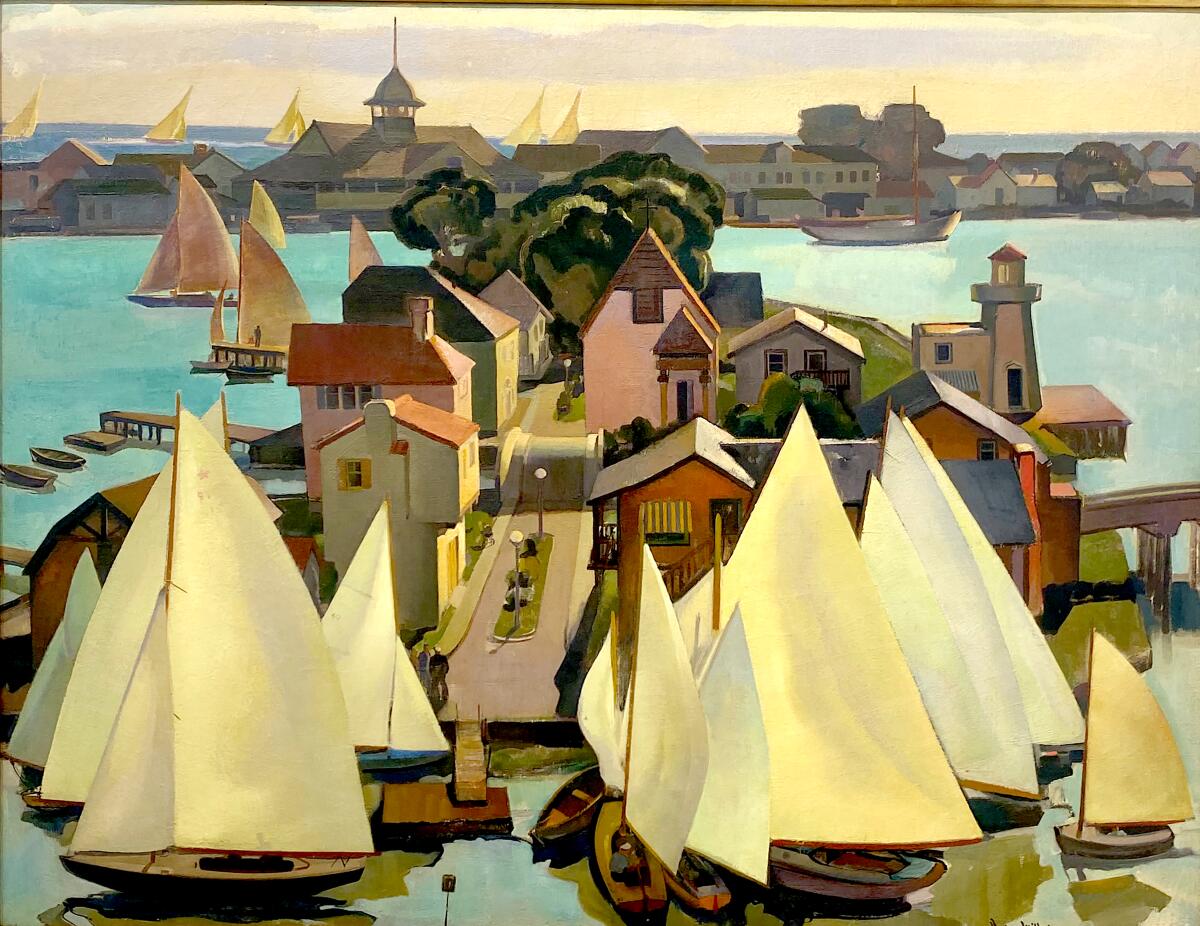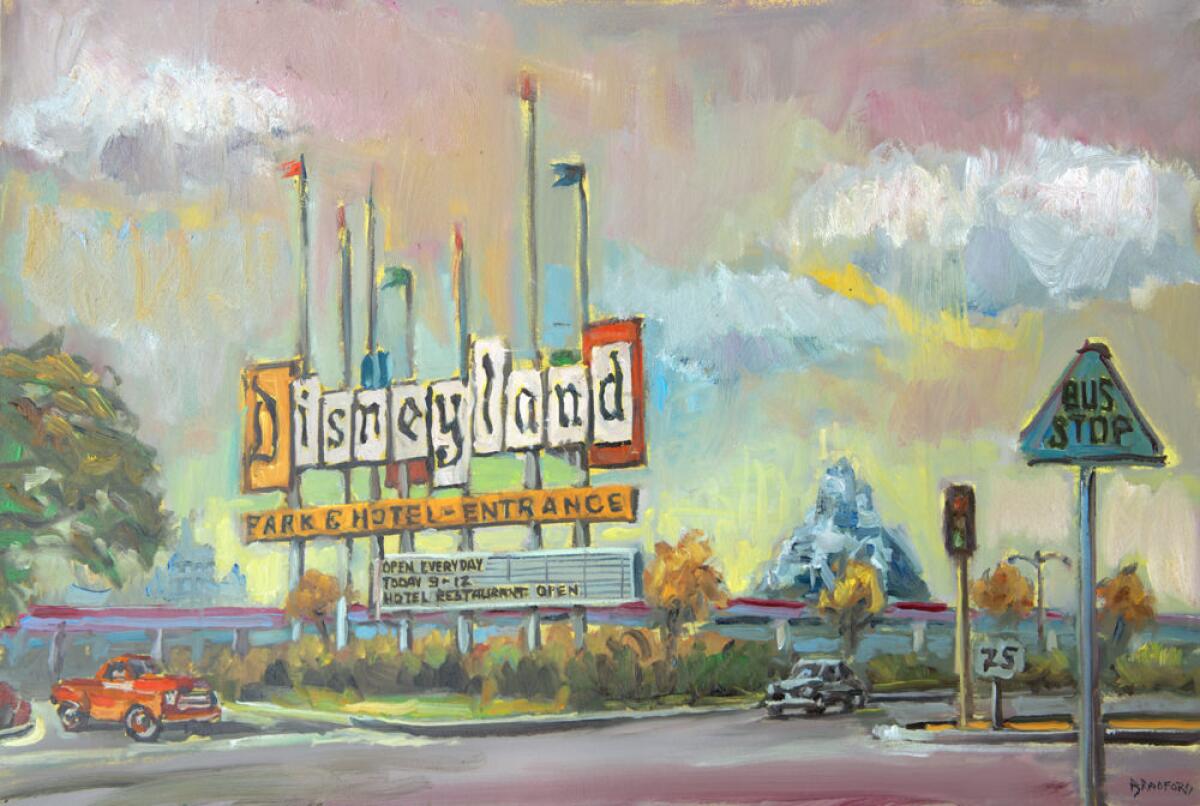Looking back: Hilbert Museum offers nostalgic ‘Views of Orange County’

- Share via
At the Hilbert Museum of California Art at Chapman University in Orange, two paintings with sailboats hang in the north gallery wing. The scenes are similar, with boats on the water, white sails aloft.
One painting is from Barse Miller, titled “Regatta (aka Sails),” from the 1930s, depicting the Balboa Pavilion in Newport Harbor. The other is a painting from the 1940s from Phil Dike, “Entrance to the Harbor,” depicting Corona Del Mar. Both artists chose boats on the coastal waters of Orange County as subjects, and yet the two works couldn’t be more different.
“Barse was a really important artist who recorded, with very great skill, what it looked like at the time,” said California and Orange County art historian Jean Stern. “He was a very good artist with a beautiful sense of depth and perspective.”
Miller was an American watercolorist, muralist and illustrator who also became an art educator and founding member of the California Watercolor Society. Miller’s boats stand tall and precise, huddling around the pavilion. Dike, on the other hand, drew boats that are more fluid. While also an American painter and art teacher, Dike was more of a modernist, Stern said.

“He is much more suggestive as to the forms, whereas Barse is very exact,” said Stern. “Dike is doing it more as work of modern art, where you, the viewer, know what it is, but he doesn’t have to go to the extreme detail to tell you that. He also creates a very vivid sense of movement.”
Dike’s boats buzz with activity, not strictly outlined but loosely interpreted and hovering on the outskirts of a scene that contains fisherman, rocks and more.
The two pieces are part of the Hilbert’s exhibition, “Same Place, Another Time: Views of Orange County,” which explores what Orange County might have looked like 20 to 100 years ago through the eyes of many different local artists. Curated by Gordon McClelland, the paintings in the collection are not just included for their beauty but for the artists’ ability to capture specific moments in Orange County history. The two sailboat paintings are an example of how different artists can interpret those moments.
“It’s two different approaches to art, and Orange County really benefited from so many different styles of artist that were working during this time period,” said Stern.
Stern, who is also director emeritus of the Irvine Museum and the author of several books on California art, including “Painting California: Seascapes and Beach Towns,” gave a lecture on the exhibition at the Hilbert on June 12, taking time for questions afterwards. His lecture, “Orange County Dreams: How California’s Great Artists Painted O.C.,” is part of an event series offered by the museum. Stern has served on the Board of Directors of the California Art Club and the Laguna Plein Air Painters Assn. and is considered an expert on paintings of the California Impressionist period.
Besides the sailboat paintings, “Same Place, Another Time” features works from important artists like Bradford J. Salamon, George James, Rosemary Vasquez Tuthill and others. Beach scenes and townscapes highlight everyday life in Laguna Beach, Newport Beach, Costa Mesa, Anaheim and Santa Ana in oils and watercolors.
Kerne Erickson, for example, is known for his airline advertisements that highlight places like Hawaii and Palm Beach, but the Hilbert Museum features his recent work, “California Gold,” a warm painting of orange groves in Villa Park.
“He’s known for a lot of posters, so this may have been used as an ad for Sunkist,” said Stern. “It shows that the oranges are mature, ripe and fresh when they are picked. The point of this painting is completely different because it wants you to understand something and possibly buy it.”
When Villa Park was still covered in orange groves, the VillaPark Orchards Assn. was responsible for harvesting and shipping most of the fruit grown there. In Erickson’s painting, a Sunkist truck loaded with orange crates is parked in an orchard where the trees, heavy with fruit, cast just enough shadow to create a little shade from the Southern California sun.
Other works feature other Orange County landmarks like the legendary music venue the Golden Bear, open in Huntington Beach from 1923 to 1986, and the Old Irvine General Store, located off the 5 Freeway at Sand Canyon Road, which served as a general store and post office for the original Irvine Ranch. And of course, Disneyland.

A 2017 painting from Bradford J. Salamon of the entrance to Disneyland in 1960 is inspired by the artist’s romanticized view of the theme park as a child. Salmon grew up 30 minutes from the Happiest Place on Earth but later became disenchanted with the commercialism that distracted him from the park’s artistry. His painting, “Disneyland Vintage 1960,” captures a nostalgic memory of a more innocent time under a blush sky.
“Salmon paints all sorts of different things and he is very popular because he has this great sense of humor,” said Stern. “He has a very childlike approach to his art.”
A crowd of nearly 3,350 visitors came out to the reopening of the Hilbert Museum in February after the museum was closed for three years of remodeling that tripled its footprint. “Same Place, Another Time” is one of nine exhibitions at the museum and will remain on view until Sept. 7. Stern said the show is a good way to get an idea of what Orange County looked like in the past and how it compares to the way the county looks now, through a multitude of perspectives.
“There are pieces here that are clearly Orange County, but you get two artists in a room, and they will paint four different ways,” said Stern. “They are always experimenting.”
All the latest on Orange County from Orange County.
Get our free TimesOC newsletter.
You may occasionally receive promotional content from the Daily Pilot.




